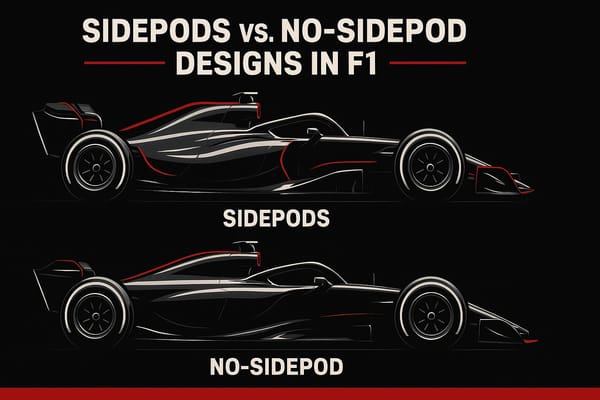ERS and MGU-H: Why 2026 Marks a Turning Point
The 2026 Formula 1 regulations will phase out the MGU-H, emphasizing an upgraded MGU-K system for cost reduction and sustainability.

Formula 1's 2026 regulations will introduce major changes to power unit technology, including the removal of the MGU-H and a shift to a more powerful MGU-K system. Here's what you need to know:
- MGU-H Removal: The MGU-H, which recovered energy from exhaust gases, will be retired due to its high cost and complexity. This aims to simplify power units and attract new manufacturers.
- MGU-K Upgrade: The MGU-K, responsible for braking energy recovery, will increase its output from 120kW to 350kW, creating a 50:50 power split between electric and combustion systems.
- Cost Cap Increase: Power unit development budgets will rise to $130 million annually to support the transition.
- Manufacturer Participation: Six manufacturers - Alpine, Audi, Ferrari, Honda, Mercedes, and Red Bull Ford - are confirmed for 2026, reflecting the appeal of the simpler engine design.
- Sustainability Goals: The new power units will use 100% sustainable fuel, aligning with F1's push for greener technology.
These changes aim to balance performance, reduce costs, and create closer competition while maintaining F1's role as a testing ground for advanced energy systems.
1. MGU-H
Technical Functionality
The MGU-H (Motor Generator Unit - Heat) is one of Formula 1's most advanced pieces of engineering. Built directly into the turbocharger, it transforms heat from exhaust gases into electrical energy. Spinning at an incredible 125,000 RPM, it can send this energy to the battery, the MGU-K for immediate use, or even back to the turbocharger for control purposes.
What sets the MGU-H apart is its lack of recovery limits, unlike the MGU-K, which is capped at 2 MJ per lap. This means it can deliver a continuous 161 HP (120 kW) boost throughout most of a lap when managed efficiently. Another standout feature is its ability to eliminate turbo lag by using electrical energy to pre-spin the turbocharger before the exhaust gases reach full flow. This ensures instant throttle response, a critical factor in Formula 1's demanding racing environment.
However, achieving this level of performance comes with its own set of challenges.
Cost and Complexity
For all its ingenuity, the MGU-H is an expensive and complicated component. Its direct integration with the turbocharger, along with the need for high-precision control systems and specialized materials capable of withstanding extreme rotational speeds, drives up costs significantly. Teams also have to tackle issues like thermal management, electromagnetic interference, and mechanical reliability, all of which become more pronounced at such high operating speeds.
These challenges have historically narrowed the field of competitive engine suppliers. In the early hybrid era, manufacturers like Renault and Honda struggled with reliability and performance as they worked to master this complex technology.
Impact on Competitive Balance
The MGU-H's technical and financial demands also created disparities between teams. Mercedes, for example, was quick to perfect the MGU-H system, allowing them to deploy energy more efficiently and eliminate turbo lag. This gave them a noticeable edge, especially on tracks with long straights where their superior energy management and drivability translated into better overall performance.
Looking ahead to 2026, Formula 1 plans to retire the MGU-H as part of its efforts to level the playing field. By removing this intricate component, the sport aims to reduce technological barriers, making it easier for new manufacturers to enter the competition. This change is expected to encourage broader participation and promote closer racing.
2. ERS (MGU-K)
Technical Functionality
With the MGU-H now retired, the MGU-K (Motor Generator Unit - Kinetic) steps into the spotlight as Formula 1's main energy recovery system for 2026. This system converts braking energy into electrical power and is directly connected to the rear axle. It can provide up to 161 HP (120 kW) to the wheels for about 33 seconds per lap.
The MGU-K is designed to recover up to 2 MJ of energy per lap and deploy 4 MJ, taking full responsibility for energy recovery under the new rules. A 50/50 power split is mandated, and a manual override system will replace DRS, allowing an extra 0.5 MJ of energy below speeds of 337 km/h to assist with overtaking.
Cost and Complexity
Compared to the MGU-H, the MGU-K is less complex and more budget-friendly. It avoids the intricate integration with turbochargers and the extreme rotational speeds of 125,000 RPM, resulting in fewer components and simpler maintenance needs. This streamlined design makes it more manageable for teams with varying levels of funding and technical expertise.
The 2026 power unit cost cap has been raised to $130 million, up from $95 million, but eliminating the MGU-H is expected to balance out much of this increase. Teams will now focus their resources on maximizing the MGU-K's performance rather than dealing with the costly and complex heat recovery systems that have dominated recent seasons.
The planned power boost from 120 kW to 350 kW will require significant upgrades in battery management and control systems. Drivers will be limited to two MGU-K units per season, with an additional unit allowed in 2026 as part of the transition period.
Relevance to Sustainability
The MGU-K plays a key role in Formula 1's sustainability goals by capturing energy that would otherwise be lost as heat during braking. This recovered energy helps lower fuel consumption and emissions, aligning with the sport's broader focus on hybrid technology and environmental responsibility.
Starting in 2026, the MGU-K will work alongside 100% sustainable fuel, creating a powerful combination that underscores Formula 1's commitment to greener practices. This innovation positions the sport as a proving ground for technologies that are increasingly relevant to road cars, where energy recovery systems are becoming more common in hybrid and electric vehicles.
By showcasing the effectiveness of kinetic energy recovery in high-performance scenarios, Formula 1 contributes to the wider adoption of these technologies in the automotive industry.
Impact on Competitive Balance
The MGU-K will play an even bigger role in shaping competitive dynamics after 2026. Energy deployment will taper off after 290 km/h and completely stop at 355 km/h for leading cars, making efficient energy management critical for maintaining track position. The manual override system adds a tactical element, giving chasing drivers a temporary power advantage during overtaking attempts.
Teams with better battery management and control software are likely to gain an edge, but the differences may not be as pronounced as they were with the MGU-H. Since the kinetic energy recovery system is standardized, innovation will focus on improving efficiency and strategic use rather than introducing groundbreaking technology.
The removal of the MGU-H is also expected to make Formula 1 more attractive to new manufacturers. Audi has already confirmed its entry, and Porsche is considering joining as well. Increased participation could lead to more competitive power unit options and narrow the performance gaps between teams, paving the way for tighter competition on the track. This shift reflects Formula 1's move toward simpler, more balanced power units that promote closer racing and a more level playing field.
F1 2026 Engines: What’s REALLY Changing?
Advantages and Disadvantages
The transition to an upgraded MGU-K system marks a significant shift in how energy recovery and system design are approached. Here's a closer look at the differences between the outgoing MGU-H system and the new ERS (MGU-K) system set to debut in 2026:
| Factor | MGU‑H (2014–2025) | ERS (MGU‑K, 2026+) |
|---|---|---|
| Energy Recovery Efficiency | Extremely high - capable of recovering 65–70% of total energy per lap from exhaust heat with no recovery limit. | Limited to 2 MJ per lap from braking energy, but with tripled power output reaching 350 kW. |
| Development & Maintenance Costs | Very high due to the 125,000 RPM operation and complex turbocharger integration. | Much lower costs thanks to simpler mechanics and operation capped at 50,000 RPM. |
| Technical Complexity | Highly complex, with integration and reliability challenges that plagued teams like Renault and Honda. | Far simpler, leveraging established regenerative braking technology with fewer moving parts. |
| Road Car Relevance | Limited - high-performance turbocharger integration isn't practical for mass-market vehicles. | High - regenerative braking systems are widely used in hybrid and electric vehicles. |
| Race Strategy Impact | Allowed continuous energy deployment while eliminating turbo lag for smooth power delivery. | Introduces a manual override system for strategic energy deployment, especially below 210 mph. |
| Manufacturer Appeal | High costs and complexity deterred new entrants. | Lower entry barriers have attracted manufacturers like Audi and Ford. |
| Reliability Record | Frequent failures impacted race outcomes. | Expected to improve due to a streamlined design and proven technology base. |
Breaking Down the Trade-Offs
The MGU-H system excelled in energy recovery, capturing up to 70% of total energy per lap from exhaust heat. Its ability to eliminate turbo lag also provided seamless power delivery. However, these advantages came at a steep price. The system's extreme complexity, operating at speeds of 125,000 RPM, made it prone to reliability issues and pushed development costs sky-high. This created a significant barrier for new manufacturers, limiting competition and innovation.
On the other hand, the upcoming MGU-K system brings a simpler, more efficient approach to energy recovery. Although it is limited to recovering 2 MJ per lap from braking energy, its power output has been tripled to 350 kW, making the power unit approximately 50% electric. This increase in electrical power helps offset the MGU-H's superior energy recovery capabilities.
The simplified design of the MGU-K also lowers costs and enhances reliability. By building on regenerative braking technology already used in road cars, the system requires fewer specialized materials and less technical expertise. This accessibility has already drawn interest from new manufacturers. Audi has confirmed its entry for 2026, and Ford has partnered with Red Bull Powertrains to develop engines for the new regulations.
One of the standout features of the 2026 system is the manual override function, which aligns with Formula 1's shift toward strategic energy management. Cars trailing at speeds below 210 mph (337 km/h) can deploy an additional 0.5 MJ of energy, effectively replacing the current DRS system. This creates fresh opportunities for overtaking while adding a new layer of strategy to race dynamics.
That said, this system isn't without its challenges. The MGU-K's recovery limit of 2 MJ per lap forces teams to carefully plan energy deployment, particularly during critical moments like turbo spool-up on corner exits. Teams will need to balance efficiency with performance, making tactical decisions on when to use their limited energy reserves.
Conclusion
The 2026 regulatory changes represent a major turning point in Formula One's hybrid era, fundamentally altering how teams approach energy recovery and power unit strategies. By removing the MGU-H system - which currently contributes around 65–70% of the energy recovered per lap - Formula One is trading peak energy efficiency for a more balanced and accessible playing field.
This shift signals a strategic evolution for the sport. With six confirmed power unit suppliers, including Audi as a new entrant, the changes are fostering greater manufacturer participation and competition.
Financially, the power unit cost cap will rise to $130 million in 2026. At the same time, the simplified MGU-K system will help reduce development and maintenance expenses by eliminating the MGU-H's complexity - a system that has posed challenges for manufacturers like Renault and Honda.
The new rules also bring tighter energy management requirements. Recovery is now capped at 2 MJ per lap, and a manual override system will replace DRS, pushing teams to manage their energy reserves with even greater precision.
Sustainability takes center stage in these regulations as well. The introduction of 100% sustainable fuel, paired with an enhanced MGU-K power output of 350 kW, demonstrates that environmental responsibility can coexist with high-performance engineering. This continues Formula One's ongoing effort to align cutting-edge technology with sustainability goals.
FAQs
What does the removal of the MGU-H mean for Formula 1 teams and their competitiveness in 2026?
The decision to remove the MGU-H (Motor Generator Unit-Heat) from Formula 1 power units starting in 2026 signals a major change in the sport's technical landscape. This adjustment aims to simplify engine designs, cut costs, and potentially attract new manufacturers to the competition. But with these benefits come new hurdles, as teams will need to rethink how they manage energy recovery and refine their overall power unit strategies.
In the absence of the MGU-H, teams will place greater emphasis on the MGU-K (Motor Generator Unit-Kinetic) for energy recovery. This shift could lead to noticeable differences in performance, as each team’s ability to optimize their systems will play a bigger role. The regulation change sets the stage for a shake-up in the competitive order, creating fresh opportunities for both established teams and newcomers to find innovative ways to gain an advantage.
How will the increased power output from the MGU-K affect race strategies and team performance in 2026?
The changes coming in 2026, particularly the increased power output from the MGU-K, are set to shake up race strategies and team dynamics in a big way. Teams will need to rethink how they handle energy recovery and deployment to squeeze every bit of performance under the updated regulations. This could open the door for bolder overtaking moves and smarter energy management during races.
With the MGU-H being phased out, the spotlight shifts entirely to the MGU-K. This makes its efficiency and reliability more important than ever. Teams that successfully fine-tune their energy recovery systems and seamlessly integrate them into their race strategies could gain a noticeable advantage on the track.
How will switching to 100% sustainable fuel in 2026 support Formula 1's environmental goals and shape the sport's future?
Formula 1 is gearing up for a major milestone: transitioning to 100% renewable fuel by 2026. This move is a cornerstone of the sport's ambitious goal to achieve net-zero carbon emissions by 2030. By using fuels made from renewable sources, Formula 1 aims to drastically cut its carbon footprint while ensuring engines continue to deliver the high-performance thrills fans expect.
This shift isn't just about motorsport - it has the potential to spark advancements in cleaner fuel technologies across industries. It also aligns with global efforts to tackle climate change, positioning Formula 1 as a leader in blending innovation with environmental responsibility. The future of racing is shaping up to be one where speed and sustainability share the same track.




